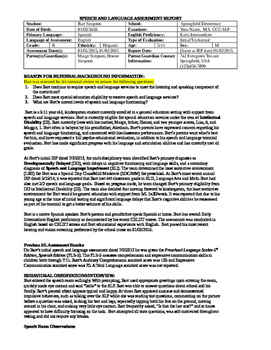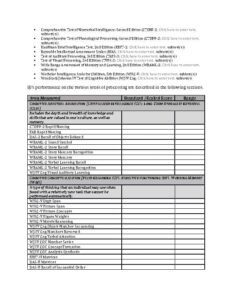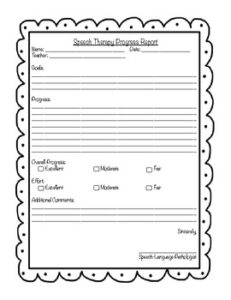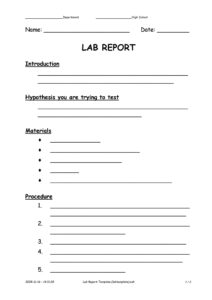As speech-language pathologists, educators, or even concerned parents, we understand the profound impact that effective communication has on a child’s development and academic success. When a child experiences difficulties with speech or language, a comprehensive evaluation becomes the cornerstone of understanding their needs and charting a path forward. This intricate process culminates in a detailed report, a document that not only summarizes findings but also guides interventions.
Crafting these reports, however, is often a time-consuming and meticulous task. It requires the careful synthesis of observations, test results, and clinical impressions into a coherent narrative that is easily understood by various stakeholders, from fellow professionals to families who may be new to the world of speech-language pathology. The goal is always to provide a clear, accurate, and actionable overview of a child’s communication profile.
That’s where a well-designed speech and language evaluation report template can become an invaluable asset. It streamlines the reporting process, ensures consistency across evaluations, and helps busy professionals maintain a high standard of documentation, ultimately allowing more time to focus on what matters most: helping children thrive.
Crafting a Comprehensive and Insightful Evaluation Report
Developing an evaluation report that truly captures a child’s unique communication profile is an art as much as it is a science. It begins long before any formal writing, with the thorough collection of background information. This typically includes a detailed case history, medical records, educational reports, and input from parents, teachers, and other professionals involved in the child’s life. Understanding the child’s developmental milestones, family history of communication disorders, and current academic or social challenges provides crucial context for interpreting assessment results.
Once the background is established, the evaluation itself involves a battery of standardized and non-standardized assessments. These might include formal tests for receptive and expressive language, articulation, phonological awareness, fluency, and voice. Observations in various settings, such as the classroom or during play, offer invaluable insights into how the child uses language in natural contexts. It is essential to select assessments that are culturally and linguistically appropriate, ensuring a fair and accurate representation of the child’s abilities.
Key Sections of Your Report
The structure of a robust evaluation report template typically includes several core components, each serving a vital purpose. After the initial identifying information and background details, a detailed section outlining the assessment procedures and tools used is essential. This not only provides transparency but also allows other professionals to understand the scope and methodology of your evaluation. Clearly listing the tests administered, along with their raw scores, standard scores, percentile ranks, and confidence intervals, is critical for data interpretation.
Following the methodology, the “Findings” section is where you delve into the heart of the child’s communication strengths and challenges. This is often broken down into specific areas such as receptive language (understanding), expressive language (speaking and communicating thoughts), articulation and phonology (speech sounds), fluency (stuttering), and voice (quality, pitch, loudness). For each area, you would describe observations, summarize test results, and provide specific examples of the child’s performance, painting a vivid picture of their communication skills. Consider adding a section on pragmatic language, exploring how the child uses language in social contexts.
Organizing Your Findings Effectively
Finally, a comprehensive report ties everything together with a summary of findings, diagnostic impressions, and specific, actionable recommendations. This part is arguably the most important for guiding intervention. Recommendations should be clear, measurable, and directly linked to the evaluation findings. They might include therapy goals, classroom accommodations, home strategies, or referrals to other specialists. A well-written prognosis, discussing the anticipated outcomes with intervention, also provides valuable information to families and other team members, offering a forward-looking perspective on the child’s communicative journey.
The Practical Advantages of a Standardized Template
Adopting a consistent speech and language evaluation report template offers a multitude of benefits that extend beyond simply saving time. For busy professionals, it provides a structured framework that guides the entire report-writing process, ensuring that no critical information is inadvertently overlooked. This standardization not only streamlines workflow but also significantly reduces the cognitive load associated with starting each report from scratch, allowing more mental energy to be dedicated to clinical analysis and personalized recommendations rather than formatting and section headings.
Moreover, a uniform template enhances the clarity and readability of your reports. When all evaluations follow a similar format, it becomes much easier for parents, teachers, pediatricians, and other therapists to navigate and understand the findings. This consistency fosters better interdisciplinary communication and collaboration, as everyone involved can quickly locate the information they need to support the child effectively. It also helps in tracking progress over time, as subsequent evaluations can be easily compared to previous ones using the same structured approach.
Beyond efficiency and clarity, using a standardized template bolsters the professionalism and defensibility of your documentation. It ensures that all necessary legal and ethical components are included, which is particularly important in educational or medical settings where reports may be used for eligibility decisions or insurance purposes. A thoughtfully designed speech and language evaluation report template acts as a quality control mechanism, upholding high standards for every document you produce and reflecting positively on your clinical practice.
Ultimately, the objective of every speech and language evaluation is to gain a deeper understanding of a child’s communication abilities and to empower them with the tools and support they need to reach their full potential. A well-constructed report serves as a powerful advocacy document, articulating needs, celebrating strengths, and outlining a clear path for intervention.
By leveraging well-designed resources, professionals can ensure their reports are not just comprehensive and accurate, but also efficient to produce, allowing more valuable time to be spent directly impacting the lives of the children and families they serve. Investing in robust documentation practices is an investment in better outcomes for all.




